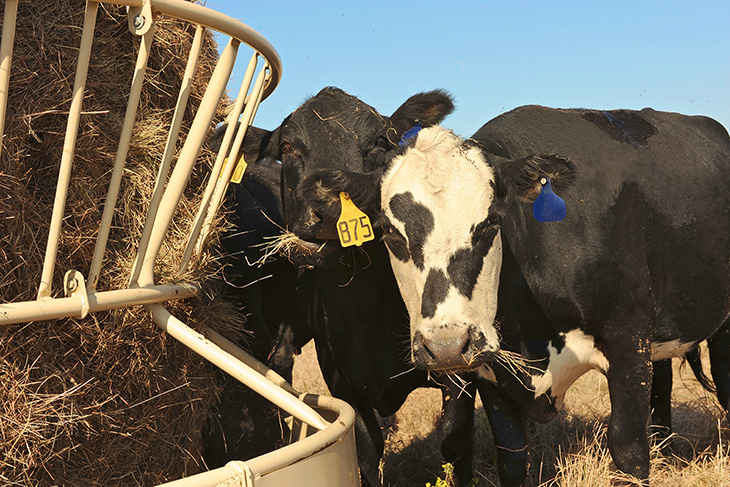
Spring-calving beef herds face nutritional challenges
Friday, March 6, 2020
Oklahoma State University animal scientists urge cattle producers to pay extra attention to the nutritional needs and body condition of their cows as spring arrives.
“Unless cool season grasses are available, this is a time of year where maintaining or gaining body condition on spring-calving cows is really quite difficult,” said Glenn Selk, Oklahoma State University Extension emeritus animal scientist and editor of the university’s popular Cow-Calf Corner newsletter.
Warm season grasses have not yet begun to grow. What little is left of dormant grasses is a low-quality feed. Cows cannot, or will not, consume a large amount of standing dormant grass.
“Cows may become deficient in energy if the only supplement is a self-fed, self-limited protein source,” Selk said. “Consider the instructions that accompany self-fed supplements: They are to be fed along with free-choice access to adequate quality forages.”
Another factor compounds the problem: A small amount of winter annual grasses may begin to grow in native pastures. These are the first tastes of green grass many cows have seen since last year.
“The cows may try to forage these high-moisture, low-energy density grasses in lieu of hay or cubes that are more energy dense,” said Brian Freking, OSU Extension area livestock specialist. “The result can be loss of body condition in early lactation beef cows just before the breeding season is about to begin.”
Research conducted through OSU’s statewide Oklahoma Agricultural Experiment Station system shows body condition at the time of calving is the most important factor affecting rebreeding performance in normally managed beef cow herds.
“Changes in body condition from the time a cow calves until she begins the breeding season can play a significant role in the rebreeding success story,” Freking said. “This appears to be most important to cows calving in the marginal body condition score range of four or five.”
OSU animal science research conducted under principal investigator Bob Wettemann and published in the 1987 Journal of Animal Science illustrates the vulnerability of cows that calve in the body condition score of five. Two groups of cows began the winter-feeding period in similar body condition and calved in very similar body condition. The average body condition score was 5.3 to 5.4.
“After calving and before the breeding season began, one group was allowed to lose almost one full condition score,” Selk said. “The other group of cows was fed adequate amounts to maintain the body condition they had prior to calving.”
The difference in rebreeding rate was dramatic, 73% to 94%.
“Cows that calve in a body condition score of five are very vulnerable to weather and suckling intensity stresses,” Selk said. “Cow-calf producers must use good nutritional strategies after calving to avoid disastrous rebreeding performance.”
Ideally, cows should maintain condition during mid-to-late pregnancy and gain during breeding. That means making maximum use of the available forage resources.
OSU recommends producers continue feeding a source of energy, such as moderate-to-good quality grass hay free choice or high-energy cubes until warm-season grasses grow enough to provide both the energy and protein lactating cows need.
Oklahoma is the nation’s third-leading producer of beef cows, according to USDA National Agricultural Statistics Service data.
The Oklahoma Agricultural Experiment Station system and OSU Extension are state agencies administered by the university’s Division of Agricultural Sciences and Natural Resources. Both are key elements of OSU’s state and federally mandated teaching, research and Extension land-grant mission.
MEDIA CONTACT: Donald Stotts | Agricultural Communications Services | 405-744-4079 | donald.stotts@okstate.edu
